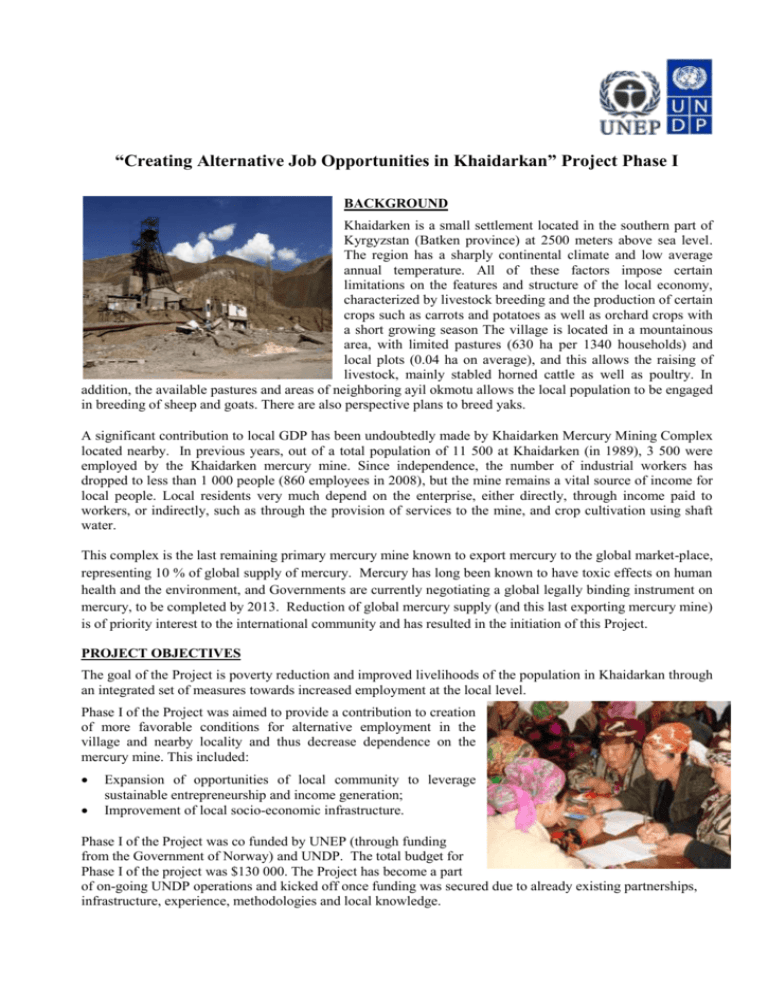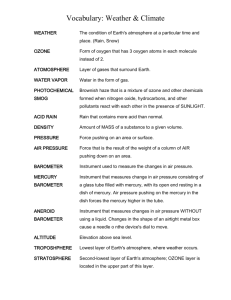Job Opportunities in Khaidarken
advertisement

“Creating Alternative Job Opportunities in Khaidarkan” Project Phase I BACKGROUND Khaidarken is a small settlement located in the southern part of Kyrgyzstan (Batken province) at 2500 meters above sea level. The region has a sharply continental climate and low average annual temperature. All of these factors impose certain limitations on the features and structure of the local economy, characterized by livestock breeding and the production of certain crops such as carrots and potatoes as well as orchard crops with a short growing season The village is located in a mountainous area, with limited pastures (630 ha per 1340 households) and local plots (0.04 ha on average), and this allows the raising of livestock, mainly stabled horned cattle as well as poultry. In addition, the available pastures and areas of neighboring ayil okmotu allows the local population to be engaged in breeding of sheep and goats. There are also perspective plans to breed yaks. A significant contribution to local GDP has been undoubtedly made by Khaidarken Mercury Mining Complex located nearby. In previous years, out of a total population of 11 500 at Khaidarken (in 1989), 3 500 were employed by the Khaidarken mercury mine. Since independence, the number of industrial workers has dropped to less than 1 000 people (860 employees in 2008), but the mine remains a vital source of income for local people. Local residents very much depend on the enterprise, either directly, through income paid to workers, or indirectly, such as through the provision of services to the mine, and crop cultivation using shaft water. This complex is the last remaining primary mercury mine known to export mercury to the global market-place, representing 10 % of global supply of mercury. Mercury has long been known to have toxic effects on human health and the environment, and Governments are currently negotiating a global legally binding instrument on mercury, to be completed by 2013. Reduction of global mercury supply (and this last exporting mercury mine) is of priority interest to the international community and has resulted in the initiation of this Project. PROJECT OBJECTIVES The goal of the Project is poverty reduction and improved livelihoods of the population in Khaidarkan through an integrated set of measures towards increased employment at the local level. Phase I of the Project was aimed to provide a contribution to creation of more favorable conditions for alternative employment in the village and nearby locality and thus decrease dependence on the mercury mine. This included: Expansion of opportunities of local community to leverage sustainable entrepreneurship and income generation; Improvement of local socio-economic infrastructure. Phase I of the Project was co funded by UNEP (through funding from the Government of Norway) and UNDP. The total budget for Phase I of the project was $130 000. The Project has become a part of on-going UNDP operations and kicked off once funding was secured due to already existing partnerships, infrastructure, experience, methodologies and local knowledge. At the same time, other related activities are underway, aimed at the reduction of most immediate threats posed by the mine site to the environment and the local population as well as the promotion of other industrial activities in the region. The ultimate goal of the overall Project is to assist the Kyrgyz Republic to transition to more sustainable economic activities over the long term, in light of the future global mercury treaty. PROJECT RESULTS AND PROPOSED INTERVENTIONS During the period from 1st September 2009 to 30 September 2010 the Programme carried out the following activities: 1. Participatory Rural Appraisal (PRA) was conducted to identify basic needs and problems impacting on local development as well as to seek potential solutions. 2. Small Capital Grant Facility was established and institutionalized through the development of a Grant Manual that promotes transparency and accountability in approval and implementation of grant projects. 3. 14 small grant project proposals were identified and funded through Small Capital Grants Facility by the local government and local community, including five small-scaled business projects which resulted in additional employment opportunities for 30 residents of Khaidarkan and nine infrastructure rehabilitation projects. 4. Over 130 people in the community benefited from training events aimed at improvement of skills and knowledge in the farm management and technologies of agriculture, business planning, various types of non-farm business activities. The creation of business enterprises (even in the communal services sector) leads to the formation of a permanent income generation source both for the owner of the enterprise as well as for the employees, and a specific focus was made to strengthen business development capacity of target beneficiaries. The Project assessed existing needs, developed and delivered a number of abovementioned capacity building events as well as gaining practical experience after the study tour. The review of selected projects demonstrates the prevalence of infrastructure problems in the village. There are certain risks in funding infrastructure projects, because people may lose jobs after the implementation of the infrastructure project activities is complete; further, there may be lack of funds to support newly created / repaired infrastructure. Nevertheless, the decision to improve community infrastructure through the Small Grants Facility was deemed an immediate priority and takes into account the interests of the majority in the community. Overall, the Project ensured mobilization of the community through their active participation in the decision making, designing and implementation of basic infrastructure and small business projects. Financial and institutional support under the Project served a tool enabling local communities to set up on-going assessment of their needs, and start addressing them on their own initiative. The Project also ensured active participation of the local governmental and nongovernmental institutes in every stage of its execution through community level partnerships, with Batken oblast and Kadamjai rayon administrations, local self government of Khaidarkan settlement and other non-governmental organizations as Batken Rural Advisor Services (RAS), Osh TES Centre and the NGO “Aktivist”. CURRENT STATUS AND NEXT STEPS During the ‘Roundtable on improving environmental safety at mercury mining sites in Kyrgyzstan’ convened by the Kyrygz Republic State Agency of Environment in Bishkek on December 15, 2010, UNDP reported on the implementation of the Phase I of the Project. The Khaidarkan town representative expressed full support of this process, and there is a clear indication that the local community is supportive of next steps and anticipates additional investment. Phase II is being initiated through a UNEP-UNDP Letter of Agreement with 200,000 USD support from the United States of America. Phase II is designed to continue to address the local main socio-economic development challenges of Khaidarkan. Additional funds are being sought to further scale up project activities. The activities during Phase II will be primarily focused on strengthening the conditions to fostering local entrepreneurship and improving agricultural practices and thus to further expand economic opportunities for 2 local community. This will be done through providing enhanced capacity development support, strengthening marketing linkages, ensuring access to marketing information and financial capital. The Project would adjust the approach based on the results and lessons learnt from the Phase I. All implementation will be closely coordinated with national and local authorities and will engage local population through participatory decision making. Drafted: 7 February 2011 Contact: Ms. Nuria Choibaeva, Programme Officer, Head of Socio-economic Development Unit UNDP-Kyrgyzstan, roza.choibaeva@undp.org, (996-312) 61-12-11 (ext.119) 3






